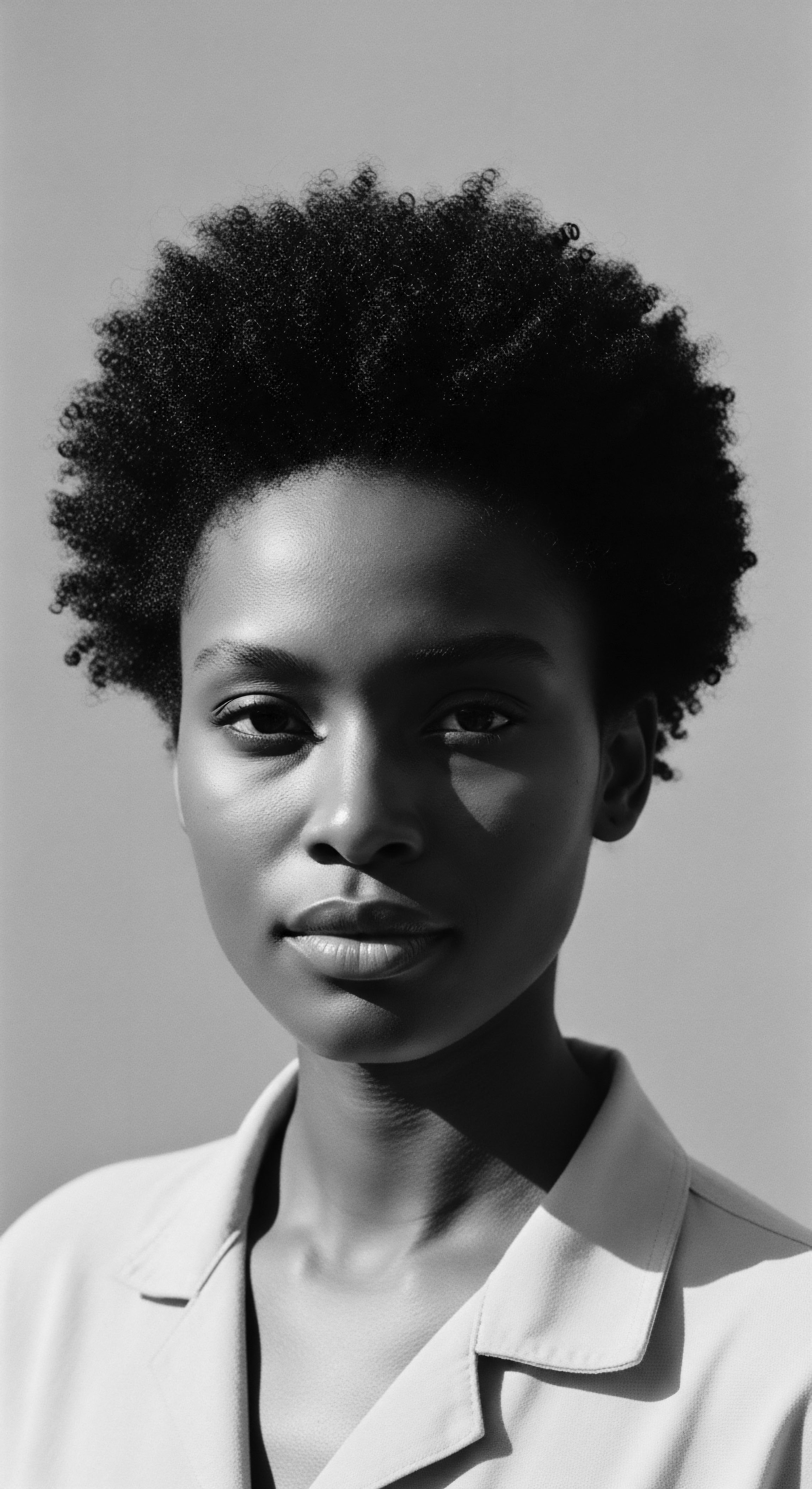
Roots
The very essence of textured hair carries within its coils and curves a profound legacy, a living chronicle of generations. It is a canvas steeped in ancestry, reflecting not merely external appearance, but stories whispered through time, practices passed from elder to child. For many, hair is a direct link to heritage, a tangible connection to cultures that honored natural resources and understood the earth’s bounty as a source of wellbeing and adornment.
The pursuit of color, in this lineage, has rarely been about fleeting trends; it has consistently been about expression, identity, healing, and cultural continuity. To truly comprehend how certain plants lend their vibrant hues to textured strands, one must journey back to the source, to the fundamental understanding of hair itself, viewed through the wisdom of ancient hands and the precision of modern science.

The Hair’s Own Canvas
Hair, at its cellular core, is protein, primarily keratin. Textured hair, with its unique helical twists and varying curl patterns, presents a distinct architecture that influences how light interacts with it and how substances adhere to its surface. Each strand emerges from a follicle, a tiny organ nestled beneath the scalp, producing a fiber whose shape is determined by the follicle’s geometry.
The inherent twists and turns in textured hair mean its cuticle, the outermost layer of overlapping scales, might not lay as flat as straighter hair. This can contribute to increased porosity, allowing for deeper penetration of moisture—or, indeed, natural pigments.
The way a plant-derived pigment interacts with this structure is a dance between cellular biology and ancestral knowledge. Unlike synthetic dyes that force their way into the hair shaft with chemical assistance, plant dyes often work by coating the strand or gently bonding with the keratin, respecting its integrity. This gentle interaction is especially important for textured hair, which can be more prone to dryness or breakage if not handled with care. Understanding this interplay informs our approach to natural coloring, recognizing a dialogue between botanicals and biology that has been happening for millennia.

Echoes from Ancient Groves
Before the advent of synthetic dyes, our ancestors, across continents and cultures, turned instinctively to the plant kingdom for color. This was not a random act, but a culmination of observant living, passed down through oral traditions and communal practice. From the earliest human civilizations, plants served as a vast palette for body adornment, textile coloring, and certainly, hair.
Pigments extracted from roots, leaves, bark, and flowers were applied not only for aesthetic purposes but often for ritual, social status, and even protection from environmental elements. The earliest known use of Henna (Lawsonia inermis) dye, for instance, was found adorning the hair of an Egyptian mummy from 3400 BCE, highlighting a practice steeped in antiquity.
The story of plant-based hair color for textured hair is a chronicle of ingenuity, deep observation of nature, and unwavering cultural expression across generations.

Pigments of the Earth
The alchemy of natural plant dyes resides in their unique chemical compounds, molecules that possess an innate ability to impart color. These are not merely superficial stains; they engage with the hair fiber, offering results that range from subtle conditioning tints to rich, lasting hues. Some of the most revered plants in this tradition include:
- Lawsone in henna, a reddish-orange pigment that binds to the keratin in hair, offering copper to deep auburn tones.
- Indigofera Tinctoria in indigo, which yields blues and, when combined with henna, creates shades of brown and black.
- Juglone in black walnut hulls, a naphthaquinone that provides rich brown and black shades.
- Chrysophanic Acid and Emodin in rhubarb root, contributing yellow, orange, and red tones, often used for lightening.
- Flavonoids and other pigments in chamomile, offering subtle lightening and brightening effects, especially on lighter hair.
- Anthocyanins and other compounds in hibiscus, which can impart reddish tints and darken hair.
Each of these botanical colorants interacts with the hair in its own way, offering a spectrum of possibilities that honor the hair’s natural inclination. The deep knowledge of these plants, gathered over countless seasons, forms the true foundation of natural hair coloring.

Ritual
The application of plant-derived color to textured hair has always been far more than a simple cosmetic procedure. It has been, and remains, a ritual—a deliberate act woven into the fabric of daily life, community gatherings, and ceremonial rites. These practices, honed over centuries, connect the individual to their lineage, imbuing each strand with intention and cultural memory. The preparation of the plant material, the mixing of the pastes, the patient waiting as the color takes hold ❉ all these steps are part of a tender thread linking past and present, a living testament to ancestral wisdom.

A Palette from the Earth’s Bounty
Consider the diverse origins of the plants that color textured hair. Henna, for example, cultivated across North Africa, the Middle East, and parts of Asia, has been used not only for hair but for intricate body art during celebrations, symbolizing joy and protection. Its ability to create a deep reddish-brown hue on hair has made it a favorite for adding warmth and vibrancy to darker strands, while also offering conditioning benefits.
In regions of West Africa, indigo, with its profound blue pigment, was central to textile dyeing and often found its way into hair preparations, sometimes combined with other plant extracts for deeper shades. The tradition of indigo dyeing, particularly among groups like the Yoruba of Nigeria and the Manding of Mali, showcases a masterful understanding of natural color.
Amla, from the Indian subcontinent, holds a revered place in Ayurvedic hair care. Its primary role is not necessarily direct coloring, but its rich vitamin C content and antioxidants are known to prevent premature graying by nourishing hair follicles and supporting natural pigmentation, essentially preserving the hair’s inherent hue. Similarly, cassia obovata, often called “neutral henna,” conditions and adds shine, giving lighter hair a golden tone without depositing a strong red pigment.
It has been traditionally used to enhance the hair’s health and appearance, a subtle but significant contribution to a holistic hair regimen. Black walnut hulls, prevalent in North America, offer deep brown to black colors, a practice adopted by early settlers from Indigenous communities who understood its potent dye properties for both hair and textiles.
Traditional plant coloring is an intimate dialogue with nature, a process that honors the plant’s offerings and the hair’s innate beauty.
The hibiscus flower, with its striking red petals, traditionally masks gray hair and imparts reddish tints, while also stimulating hair growth. Rhubarb root, historically used for over three millennia, contributes yellow and lighter tones, a testament to ancient knowledge of its lightening capabilities. Even common garden sage and chamomile, long celebrated for their medicinal properties, find their place in this botanical repertoire, with sage offering subtle darkening and chamomile providing gentle lightening, often used in infusions and rinses.

The Hand That Mixes
Preparation of these plant dyes often involves simple yet precise methods, passed down through generations. Dried plant materials are typically ground into fine powders, then mixed with liquids like warm water, tea, or even acidic mediums such as lemon juice, to facilitate dye release. The texture of the hair, its porosity, and previous treatments all influence how the pigment adheres. For textured hair, which can vary widely in porosity, proper preparation ensures the dye binds effectively without over-drying.
The consistency of the paste, its application method, and the duration of processing were all learned and refined through centuries of observation, often shared within family or community settings. This practical knowledge is a cornerstone of hair heritage, as important as the plants themselves.
| Plant Source Henna (Lawsonia inermis) |
| Traditional Color Range Copper to Deep Auburn, Reddish-Brown |
| Key Heritage Regions of Use North Africa, Middle East, Indian Subcontinent |
| Plant Source Indigo (Indigofera tinctoria) |
| Traditional Color Range Deep Blue, Black (when mixed with Henna) |
| Key Heritage Regions of Use West Africa, Indian Subcontinent, Southeast Asia |
| Plant Source Amla (Emblica officinalis) |
| Traditional Color Range Enhances Natural Dark Tone, Prevents Graying |
| Key Heritage Regions of Use Indian Subcontinent (Ayurvedic practices) |
| Plant Source Black Walnut Hulls (Juglans nigra) |
| Traditional Color Range Brown to Dark Black |
| Key Heritage Regions of Use North America (Indigenous Peoples), Europe |
| Plant Source Hibiscus (Hibiscus rosa-sinensis) |
| Traditional Color Range Reddish Tints, Darkens Hair, Masks Gray |
| Key Heritage Regions of Use South Asia, Southeast Asia, Caribbean |
| Plant Source Rhubarb Root (Rheum spp.) |
| Traditional Color Range Yellow, Golden Blonde, Light Brown |
| Key Heritage Regions of Use Central Asia, Europe (Traditional Chinese Medicine) |
| Plant Source These plant dyes, rooted in diverse ancestral traditions, offer a spectrum of colors while honoring hair's natural composition. |

Does Textured Hair Respond Differently to Plant Pigments?
The unique physical structure of textured hair means plant pigments interact with it in distinct ways. The varied curl patterns, from waves to coils, possess cuticles that may be raised or unevenly distributed, potentially allowing for greater absorption of dye molecules compared to straight hair. Yet, this same characteristic can also lead to faster color fade or uneven color distribution if not applied with a deep understanding of the hair’s specific needs.
For example, highly porous textured hair might absorb pigment quickly, leading to deeper, sometimes more intense results, while less porous strands might require longer processing times. The traditional knowledge embedded in many ancestral practices often accounts for these variations, guiding the nuances of preparation and application to achieve desired outcomes across a wide array of hair types within a community.
Beyond simple absorption, the natural oils and the inherent color of textured hair also play a role. Many textured hair types tend to be darker, meaning plant dyes often provide rich undertones or subtle shifts in hue, rather than dramatic transformations. Henna, for instance, adds warm, reddish tones that appear as highlights in direct sunlight on dark hair, or a vibrant copper on lighter strands. The beauty of these plant dyes lies in their ability to work with the hair’s existing color, creating results that feel organic and harmonized with the individual’s natural palette, a reflection of nature’s subtle artistry.

Relay
The wisdom of plant-based hair coloring is not a static relic of the past; it is a living, evolving current, a profound relay of knowledge across generations and geographies. The traditional uses of these botanical colorants speak to resilience, adaptation, and an enduring connection to earth wisdom, especially within Black and mixed-race communities. This legacy has navigated the currents of historical shifts, cultural impositions, and scientific inquiry, continually asserting its relevance in a world often drawn to artificial solutions. The ongoing journey of these plant dyes reminds us that true innovation often lies in returning to the source, in honoring the deep understanding our ancestors cultivated.

Sustaining the Hue Across Generations
The continuity of plant-based hair practices is a testament to their efficacy and cultural significance. For communities with a deep historical reliance on natural resources, hair coloring was often intertwined with medicinal uses, symbolic meanings, and communal identity. The act of gathering, preparing, and applying these botanical dyes became a powerful means of cultural transmission. Grandmothers taught daughters, aunts guided nieces, and the collective memory of the plant’s properties, the proper mixing ratios, and the ideal application techniques were preserved and passed forward.
This intergenerational learning fostered a reverence for the plants themselves, recognizing them as sacred gifts from the earth. The knowledge persisted even through eras of forced displacement and cultural suppression, adapting and finding new expressions in unfamiliar lands, reflecting the tenacity of the human spirit.
For instance, the use of natural plant materials for hair care and coloring extended into the African diaspora, even amidst the harsh realities of enslavement. In a poignant reflection of resilience, enslaved Africans in the Americas, stripped of traditional tools and resources, improvised with available natural materials. Ayana Byrd and Lori Tharps note in Hair Story ❉ Untangling the Roots of Black Hair in America that during this period, enslaved Black women utilized substances such as coffee as a natural dye.
This practice speaks to an incredible adaptability and a profound commitment to self-adornment and cultural continuity, even under unimaginable duress. The simple act of using a common beverage for hair color embodies a powerful narrative of ancestral ingenuity, a determination to maintain beauty and identity against overwhelming odds.

The Chemistry of Ancestral Color
Modern science now offers validation for much of what ancestral practitioners knew intuitively. The chemical compounds within plants—flavonoids, quinones, tannins, and more—are indeed responsible for their coloring properties and their benefits to hair health. For example, the lawsone molecule in henna binds directly to the keratin protein, creating a stable, long-lasting color.
Indigo’s indigotin pigment also interacts with the hair’s structure, producing a blue hue that, when layered with henna, can create true blacks. Research into the bioactive compounds of plants like amla confirms its rich antioxidant profile, which can support melanin production and protect against premature graying, aligning with its ancient Ayurvedic uses for hair preservation.
This scientific understanding does not diminish the wisdom of past practices; rather, it underscores the empirical foundation upon which those traditions were built. The meticulous observation of natural processes, the trial and error over countless generations, led to sophisticated systems of hair care that modern chemistry now deconstructs and explains. The synergy between botanical science and historical application offers a deeper appreciation for the intelligence woven into ancestral methods, proving that what was once considered folk wisdom holds rigorous scientific truth.

How Have Plant Color Traditions Been Maintained Through the Diaspora?
The journey of plant coloring traditions through the diaspora is a testament to cultural memory and adaptation. When enslaved peoples were forcibly removed from their homelands, they carried with them intangible heritage—including knowledge of plant properties and self-care rituals. While specific plant availability changed, the underlying principles of using natural remedies for hair remained.
This led to innovations with new, locally available plants and a continuation of the spirit of natural care. The enduring presence of henna in North African and Middle Eastern communities, even as populations shifted, demonstrates how cultural practices become rooted and adapt across changing societal landscapes.
The legacy of using plants for hair coloring extends beyond just the application; it is also about the stories, the communal bonding, and the resilience embedded in these practices. In many contemporary Black and mixed-race communities, a resurgence of interest in natural hair care has reignited this connection to plant-based remedies. This movement often seeks to reclaim and celebrate hair textures and care practices that were historically devalued, finding empowerment in ancestral traditions. The return to natural plant dyes represents a conscious choice to align with heritage, prioritize holistic health, and embrace an aesthetic that is inherently connected to the earth and its history.
- Ancestral Adaptation ❉ Forced migrations led to innovative substitutions, using locally available plants in new lands while preserving the spirit of traditional care.
- Cultural Retention ❉ Despite pressures to conform to Eurocentric beauty standards, many communities maintained private, intergenerational practices of natural hair care.
- Modern Revival ❉ The contemporary natural hair movement actively researches and re-adopts historical plant-based coloring methods, driven by a desire for health and cultural connection.

Reflection
The journey through the realm of plants that color textured hair naturally is more than a mere exposition of botanical science or historical fact. It is a profound meditation on the enduring soul of a strand, a testament to the ways in which hair, in its very structure and adornment, serves as a living archive of heritage. From the roots, where ancestral wisdom met the elemental biology of the hair fiber, through the rituals that sustained communities and cultural identity, to the ongoing relay of knowledge that adapts and reaffirms its power in the present moment—each step highlights a legacy of ingenuity and profound connection.
Textured hair, with its unique story etched in every coil and curl, stands as a resilient symbol. Its care and adornment, particularly through the earth’s own pigments, represent a continuity that transcends time and hardship. These plant allies, from the vibrant henna to the deep indigo, the restorative amla to the subtle chamomile, offer more than just color; they offer a connection to the earth, a gentle affirmation of natural beauty, and a tangible link to the practices of those who came before us. This is the heart of Roothea’s ethos ❉ to see in every strand not just hair, but a history, a heritage, a living, breathing archive of ancestral wisdom and timeless beauty.

References
- Byrd, Ayana, and Lori Tharps. Hair Story ❉ Untangling the Roots of Black Hair in America. St. Martin’s Press, 2001.
- Humphrey-Newell, Diane M. “Henna ❉ Uses of It in the Middle East and North Africa.” CSDT, 2013.
- Kama Ayurveda. “Hibiscus For Hair Growth ❉ Benefits + 16 Ways To Use.” 2024.
- Medical News Today. “Amla oil ❉ Does it really work for hair growth?” 2018.
- Nkosi, L. K. Adebayo, A. T. & Okoh, A. E. “Traditional Uses of African Plants in Hair Care.” Journal of Pharmacy and Alternative Medicine, 2017, vol. 1, no. 1, pp. 1-7.
- NPR. “Excerpt ❉ ‘Indigo ❉ In Search of the Color that Seduced the World’.” 2011.
- ResearchGate. “Hibiscus and cornflower – raw materials for natural hair dyeing.”
- Shepherd Textiles. “Dyeing With Black Walnut Hull (Juglans Nigra).”
- The Henna Guys. “What is Cassia Obovata Powder – Is it the Perfect Hair Conditioner?” 2021.
- The Henna Page. “Walnut, Silver Nitrate, and Para-phenylenediamine as Brunette Hair Dye.”
- UNESCO Intangible Cultural Heritage. “Henna ❉ rituals, aesthetic and social practices.” 2024.
